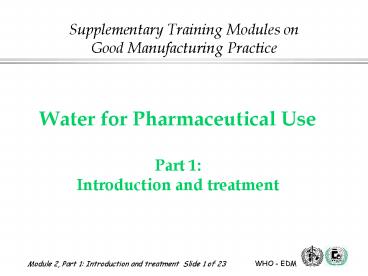Water for Pharmaceutical Use Part 1: Introduction and treatment - PowerPoint PPT Presentation
1 / 23
Title:
Water for Pharmaceutical Use Part 1: Introduction and treatment
Description:
Systems must be properly validated ... Nearby septic systems. Hazardous materials usage (pesticides, fertilizers, etc) 'Potability' ... – PowerPoint PPT presentation
Number of Views:213
Avg rating:3.0/5.0
Title: Water for Pharmaceutical Use Part 1: Introduction and treatment
1
Water for Pharmaceutical Use Part 1
Introduction and treatment
- Supplementary Training Modules on Good
Manufacturing Practice
2
- Objectives
- Introduction to Water for Pharmaceutical Use
- Review WHO GMP guidance
- Sources and types of water for pharmaceutical use
- Storage of bulk, untreated raw water
- Pre-treatment of water
3
- Principles (1)
- Like any starting material, water must conform to
Good Manufacturing Practice norms - It must be potable and comply with WHO
Guidelines for drinking-water quality
4
- Principles (2)
- Potential for microbial growth
- Systems must be properly validated
- Water for parenteral use could be contaminated
with pyrogens or endotoxins - Specifications and periodic testing is required
Annex 5, 7.2.4 Excipients,
5
- Types of water used in pharmaceutical processes
- Purified water
- Water for Injections PFW WFI
- Softened Water
- Water for Final Rinse
- Pure, or clean Steam
- Water for cooling Autoclaves
6
- Why purify raw water?
- Although reasonably pure, it is always variable
- Seasonal variations may occur in water
- Some regions have very poor quality water
- Must remove impurities to prevent product
contamination. - Control microbes to avoid contaminating products
7
- Contaminants of water (1)
- There is no pure water in nature, as it can
contain up to 90 possible unacceptable
contaminants - Contaminant groups
- Inorganic compounds
- Organic compounds
- Solids
- Gases
- Micro-organisms
8
- Contaminants of water (2)
- Treatment depends on waters chemistry and
contaminants, influenced by - Rainfall
- Erosion
- Pollution
- Dissolution
- Evaporation
- Sedimentation
- Decomposition
9
- Contaminants of water (3)
- Problem minerals
- Calcium and magnesium
- Iron and manganese
- Silicates
- Carbon dioxide
- Hydrogen sulfide
- Phosphates
10
- Contaminants of water (4)
- Further problem minerals
- Copper
- Aluminium
- Heavy metals
- Arsenic, lead, cadmium
- Nitrates
11
- Contaminants of water (5)
- Micro-organisms Biofilm
- Algae
- Protozoa
- Cryptosporidium
- Giardia
- Bacteria
- Pseudomonas
- Gram negative, non-fermenting bacteria
- Escherichia coli and coliforms
12
- Biofilm formation
- Free swimming aquatic bacteria use
polymucosaccharides to colonise surfaces - Complex communities evolve which shed
micro-colonies and bacteria
13
- Turbidity
- Silt, clay, and suspended material cause
turbidity - Small particles include "colloids"
- Removal of colloids is usually the first step in
water treatment
14
Water hardness
15
- Source of raw water
- Rain water
- Surface or ground water
- Well or borehole
- Municipal or civil tap water
- Purchased in bulk
16
- Well water
- Inspect exposed parts of the well
- Depth of well
- Check
- Nearby septic systems
- Hazardous materials usage (pesticides,
fertilizers, etc) - Potability
- Well maintenance
17
- Raw water storage
- May be required prior to pre-treatment according
to local circumstances - Check material of construction
- Concrete, steel are acceptable but check
corrosion - Plastics or plastic linings may leach
- Check cover
- To keep out insects, birds and animals
- Check disinfection practices
18
- WHO water treatment guidance
- The following should be monitored
- Sources of water
- Treatment procedures
- Water treatment equipment
- Treated water tests
- Monitoring records required
Annex 1, 17.42
19
- Pre-treatment steps
- Primary filtration and multi-media filter
- Coagulation or flocculation
- Desalination
- Softening
20
- Chlorine removal Activated-carbon (AC)
filtration - or bisulphite
- AC removes chlorine but bacteria can then grow
- AC filtration can remove organic impurities
- Bisulphite leaves sulphate residues but is
- anti-microbial
21
(No Transcript)
22
Water Softener schematic drawing
by pass valve
brine and salt tank
brine
drain
23
Water pre-treatment complex External raw water
storage
Pretreatment room































